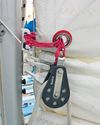
One thing everyone knows about taking a sailing yacht into the French canals is that you have to take the mast – or masts – down first. Yet, while we had got everything else ready – extra fenders, long mooring lines, folding bikes, mast crutches, and even the required navigation qualification – the one thing we had never done was actually take the masts down. This might seem a straightforward procedure, but when you have a 40-year-old boat with free-standing, carbon-fibre masts which have probably never been lowered since she was built, nothing is straightforward.
These were the thoughts going through my brain as the crane in Le Havre tugged on the mizzen mast – 500kg, 600kg, 700kg, 800kg. STOP! By now the coachroof was bulging and the whole boat seemed to be lifting out of the water. Clearly something wasn’t right. The crane eased off. Luckily, the crane operator was a Mini-Transat sailor himself and had lowered and raised countless carbon-fibre masts. Between us, we worked out that the stainless steel plate had to be removed to release the nylon wedge which was holding the mast in place.
Once again the crane lifted – 500kg, 600kg, 700kg, 800kg. STOP! And still nothing happened. Then I jumped on the coachroof, and with a shudder the mast came sliding out and the boat settled back in the water. We could all breathe again. Now we knew what we were doing, the main mast came out much more easily, and two hours (and 200 euros) later, both masts were sitting snugly on their wooden crutches. We were back in business.
This story is from the {{IssueName}} edition of {{MagazineName}}.
Start your 7-day Magzter GOLD free trial to access thousands of curated premium stories, and 9,000+ magazines and newspapers.
Already a subscriber ? Sign In
This story is from the {{IssueName}} edition of {{MagazineName}}.
Start your 7-day Magzter GOLD free trial to access thousands of curated premium stories, and 9,000+ magazines and newspapers.
Already a subscriber? Sign In

I WAS THE ONLY SAILOR ON OUR FAMILY CHARTER AND IT HAD TO GO WELL
Crystal waters, cliff tombs and sunken outboards lain Willis wanted to ensure plain sailing for his family’s first charter around Turkey's Lycian Coast

HOW IT WORKS SEAWATER PUMP
The water and oil seals on a water pump shaft will eventually wear with time, leading to pump-shaft corrosion or loss of engine oil.

THOUSANDS OF MILES ACROSS THE INDIAN OCEAN
Floris and Ivar battled severe weather and cross swell to sail from Australia to South Africa, but there were beautiful islands on the way

The secret of yachts with enduring appeal
Fashions come and go, but J-Boats remain a safe choice for great sailing boats, whether you want to own it for ever or sell it

Tragic sinking of Bayesian; Italian prosecutors investigate
The sinking of the Bayesian superyacht in reportedly only 16 minutes and the tragic loss of seven lives has sent a shudder through the sailing community and beyond.

THE ADVENT OF MARINE AI TECHNOLOGY
Fonathon Savill reports on the revolutionary impact artificial intelligence is about to have on all areas of life at sea

IMPROVING SINGLE-LINE REEFING
Martin Watts explains how to reduce the friction on the reefing lines of newer yachts

The secrets of skippering a successful cruise
Setting off on a cruise is easy, but planning a route that keeps your options open and ensures the enjoyment of all on board is more of an art

CRUISING THE KINGDOM OF THE ISLES
Joanna Martin and her husband Mark sail across the Irish Sea to the legendary sea kingdom and to draw the wonderful wildlife there

MOODY DS48
Can a boat built for long-term, long-distance cruising and offering one-level living still deliver an enjoyable sailing experience? Theo Stocker sets sail across the English Channel to find out